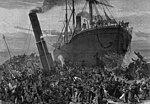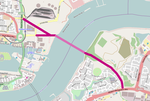Creekmouth
Areas of LondonDistricts of London on the River ThamesDistricts of the London Borough of Barking and DagenhamPort of LondonUse British English from August 2015

Creekmouth is an area of Barking in east London, England. It is best known for its large industrial estate. The industrial area around River Road and Thames Road is one of the London Borough of Barking and Dagenham's largest employment areas. Creekmouth has a wide range of businesses from small local manufacturers to major multi-national companies.
Excerpt from the Wikipedia article Creekmouth (License: CC BY-SA 3.0, Authors, Images).Creekmouth
River Road, London Barking Riverside (London Borough of Barking and Dagenham)
Geographical coordinates (GPS) Address Nearby Places Show on map
Geographical coordinates (GPS)
| Latitude | Longitude |
|---|---|
| N 51.5169 ° | E 0.0991 ° |
Address
River Road
IG11 0DS London, Barking Riverside (London Borough of Barking and Dagenham)
England, United Kingdom
Open on Google Maps









